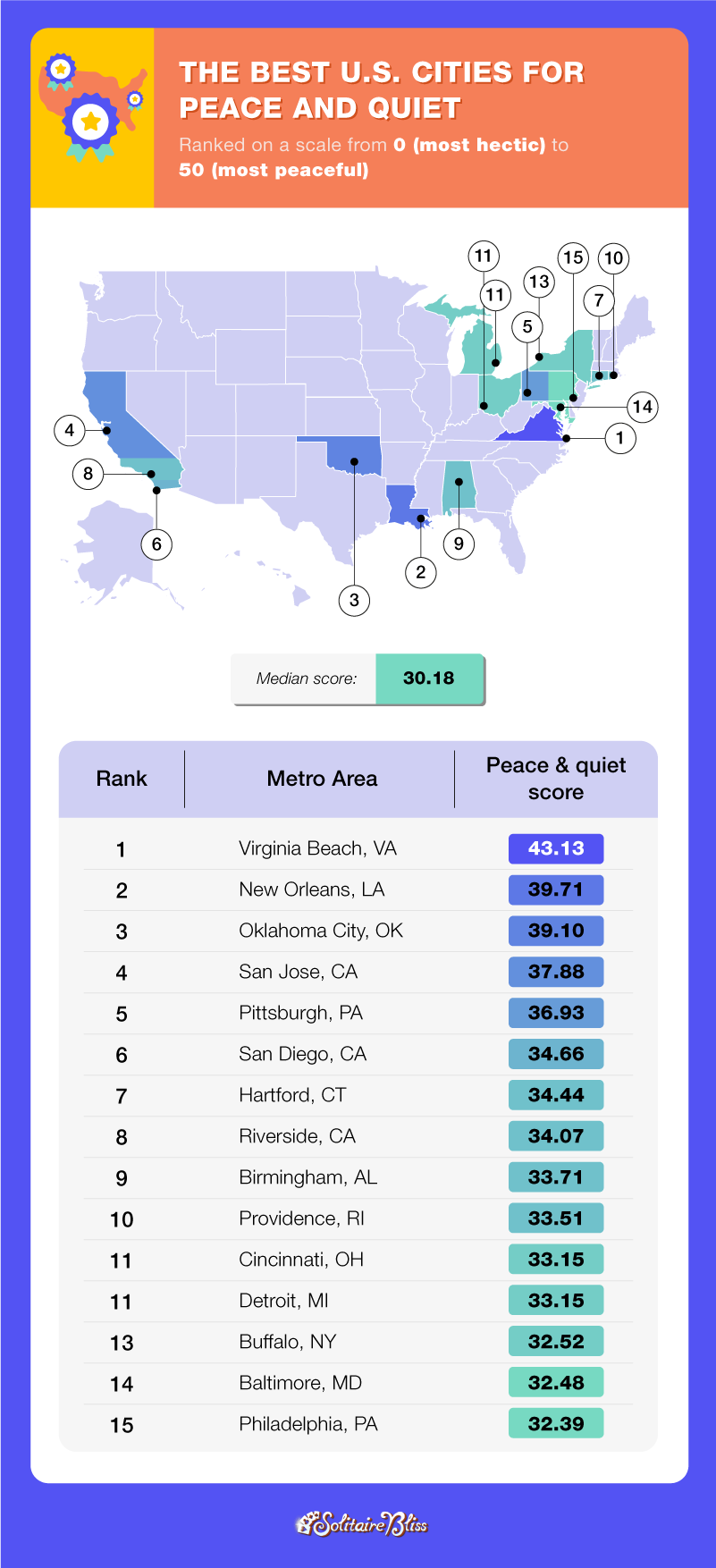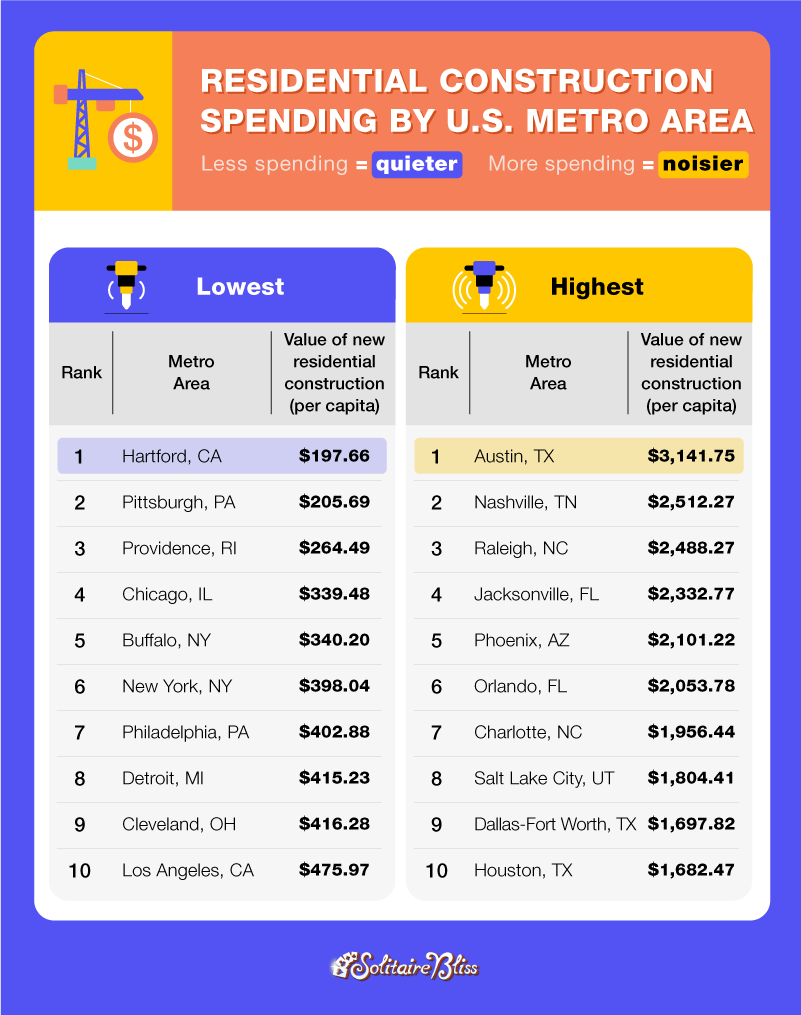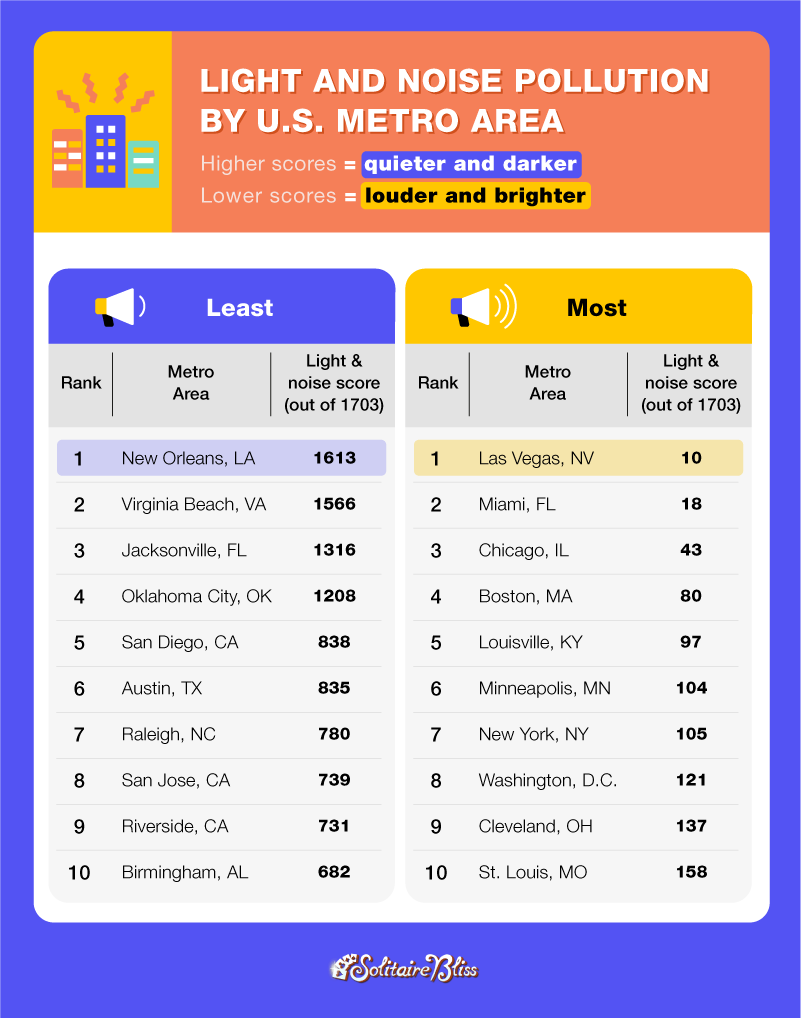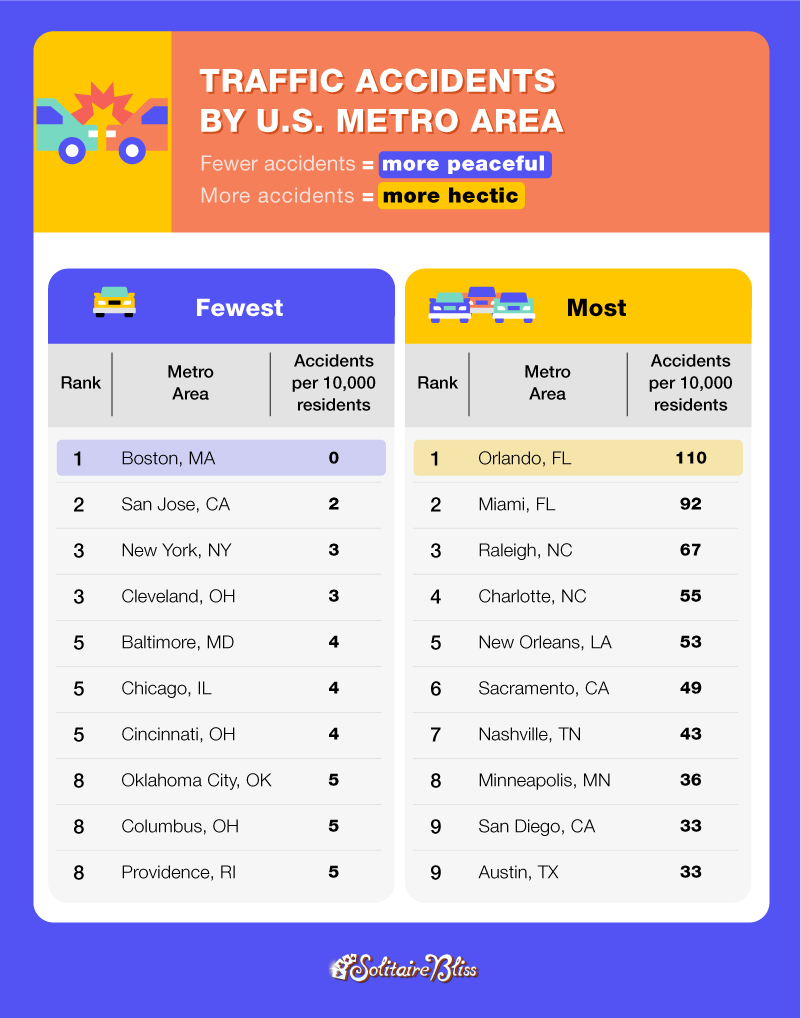Quietest cities in U.S. statistics

During the past two years, many Americans have been trying to slow down: they’re swapping cities for smaller towns, and picking up relaxing hobbies like gardening and Solitaire. Although we can’t all escape to the countryside for some peace and quiet, you can still find some solace in major metropolises.
To figure out which of the 50 biggest cities in the U.S. offers some respite from the hustle and bustle of modern life, we dug into data on everything from light pollution to noise levels to traffic accidents. To rate each city according to its level of “peace and quiet,” we created an index score that combines some key factors of a peaceful life.
This post reveals how each town stacks up.
Key findings
-
The Virginia Beach, VA, New Orleans, LA, and Oklahoma City, OK, metro areas are the most peaceful big cities in the U.S.
-
Raleigh, NC, Miami, and Orlando, FL, are the least peaceful cities.
-
Some Southern cities are growing fast: Austin, TX, Nashville, TN, and Raleigh, NC, have the highest per-capita spending on new residential construction.
The best major U.S. cities for peace and quiet
To create our peace-and-quiet scores, we analyzed three key factors for each city: residential construction spending, light and noise pollution and traffic accidents. We used these measures as proxies for crowded, loud cities that can make city life more stressful than blissful. The cities with the combined highest scores reflect the quietest, most peaceful cities while those with lower scores indicate more hectic and loud environments.

#1: Virginia Beach, VA, metro area
-
Construction spending per capita: Moderate
-
Light and noise pollution: Low
-
Number of traffic accidents: Low
Virginia Beach ranked number-one on our peace-and-quiet scale with a score of 43.13 out of 50. Because it does have moderate residential construction spending, you might hear some hammering during the day, but its overall light and noise pollution and number of traffic accidents are lower than those in many other major U.S. cities.
#2: New Orleans, LA, metro area
-
Construction spending per capita: Low
-
Light and noise pollution: Low
-
Number of traffic accidents: Moderate
You might think of New Orleans as synonymous with nightlife on Bourbon Street, but most of the town is more lowkey. It’s a walk-friendly community with quiet residential areas. The area scored a 39.71 out of 50 thanks to its relatively low residential construction spending and low light and noise pollution.
#3: Oklahoma City, OK, metro area
-
Construction spending per capita: Moderate
-
Light and noise pollution: Low
-
Number of traffic accidents: Low
Oklahoma City offers another great option for those who want city-style amenities without the overwhelming hustle and bustle—at 39.10 out of 50, it ranked third on our scale. Although you might encounter a bit of construction, the light and noise pollution is minor, and a low number of traffic accidents suggest calmer drivers and open roads.
What makes a big city good for peace and quiet?
We broke down the factors that make larger cities good options for quiet and solitude, even those with urban settings.
Minimal residential construction
Nothing ruins a restful morning like construction workers drilling one building over. We included residential construction spending in our index scoring as a marker of a city’s expansion—and all the people and noise that come with it.
The cities with the lowest spending are Hartford, Pittsburgh and Providence. On the other hand, Austin, Nashville and Raleigh are spending thousands per head on new residential buildings. These Southern cities are certainly fun, but they’re not the quiet towns they used to be.

Low levels of light and noise pollution
There’s a reason Las Vegas and New York are often referred to as cities that never sleep: 24-hour businesses, tons of tourists—it all makes for a loud, bright place, even in the middle of the night.
Cities with lower levels of light and noise pollution, like New Orleans, Virginia Beach and Jacksonville, are much more peaceful by comparison.

Few traffic accidents
If there’s one thing that can make a city feel crowded and overwhelming, it’s tons of traffic and angry drivers. High rates of traffic accidents indicate congested streets and stressed residents, while fewer accidents is a sign of better traffic flow, more space and even more relaxed people.
Though Boston, San Jose and New York are definitely crowded cities, they have the fewest number of traffic accidents per capita. In each of these cities, expensive public transportation systems offer alternatives to stressful driving situations.

Methodology: To compare levels of “peace and quiet” in different U.S. cities, we created an index score from for each city based on three criteria:
-
Residential construction spending in each MSA (per capita): We pulled data from Construction Coverage's Census-based analysis on construction spending. The higher an MSA's spending, the more noise and disruption, and the lower the score.
-
Light and noise pollution in each MSA's major city: We used the Dept of Transportation and Earth Observation Group - Colorado School of Mines Payne Institute for Public Policy, Esri map to measure noise and light pollution in each metro area’s biggest and busiest city. The more of each type of pollution, the lower the score.
-
Accidents in each MSA's major cities (per 10,000 residents): We pulled a countrywide traffic accident dataset and added up the number of accidents in the major city and outlying areas (e.g., Austin, Round Rock and Georgetown) for each metro area. The total was divided by the metro area’s population to calculate an accident rate per 10,000 residents. The more accidents per 10k residents, the lower the score.
Each factor was weighted equally. Cities were scored from 1 to 50; the higher the score, the more peaceful the city.
Back to the Homepage



